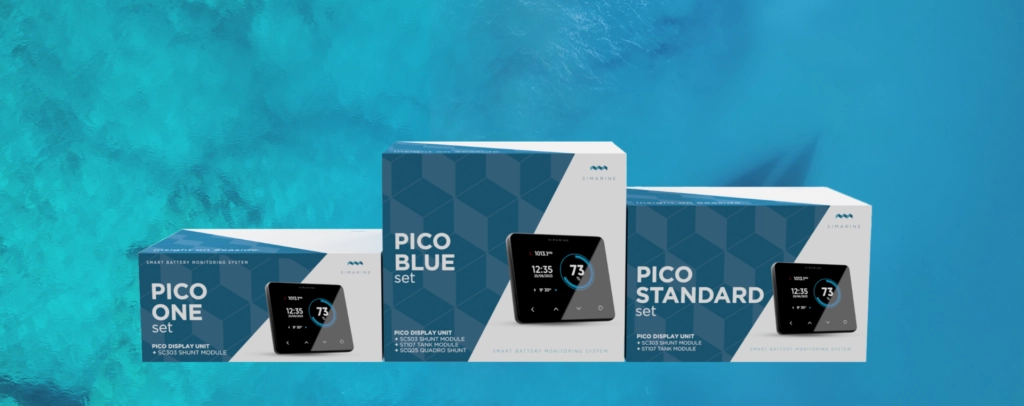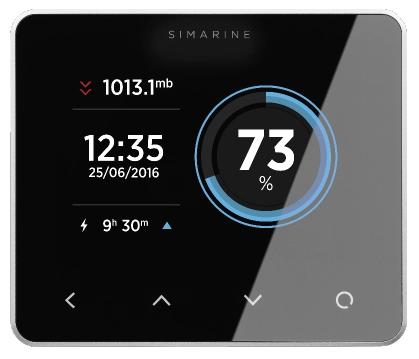Understanding electricity, how batteries work and monitoring energy consumption is not for everyone. But if you’re a boat or vacation boat owner and enjoy sea adventures or longer land getaways, then it’s imperative that you know at least the basics. This is the only way you will always have the status of key parameters under control. In this article, we will explain the operation of our system in a simple way, explain the basics of battery monitoring and help you choose the right shunts for your style of travel.
Pico battery monitoring system is modular
Our Pico system allows you to monitor the state of the batteries, their capacity, voltage, current current, remaining time with current consumption, as well as monitoring water levels, fuel, temperatures, inclination of the vehicle or vessel, measuring the energy consumed by individual devices (refrigerator, lights , hob…) and others.
The central device of our system is the PICO monitor, which displays all the above data. To deliver this data, you need to add shunts and other modules to the PICO. Our system is modular, which means that you can build your own system and add only the modules you need. Each module can be purchased individually, and which ones you choose will depend on what you want to monitor on your vessel or RV.
Do not worry if you have selected too few shunts or modules to start with, because you can always expand the system later with additional ones. You will probably add new devices to your vessel or vehicle over the years, for which you will want accurate insight into energy consumption. The modularity of our system thus gives you plenty of freedom and enables flexibility regarding the data you want to always have available.
Knowing the inputs of our modules is the base
When choosing your extra modules, the first thing you have to know is what kind of inputs each one provides and what you can connect to them.
The inputs that our system offers, are as follows:
- Resistance (to connect tank level or temperature sensors of resistance type)
- Voltage (to connect tank level sensors of voltage type, custom user sensor or use the input for battery monitoring)
- Current (for complete battery monitoring solution – which has to be accompanied by a voltage reading of the battery, from one of the previously mentioned voltage inputs)
Before we begin, let’s first look at what information is required to monitor batteries, tanks, temperature sensors and user sensors.
Batteries monitoring
Please keep in mind that when we talk about a battery, it doesn’t matter if it’s a single battery or a battery bank consisting of multiple batteries. In both cases, the system considers them as a single battery.
You can monitor a battery in two ways: either by voltage-only monitoring or full battery monitoring, which with the voltage also requires the information about the current that is going in and out of the battery.
1. Voltage only monitoring
Voltage-only gives you the state of charge solely from the voltage reading. This type of battery monitoring is suitable for an engine battery or for thruster batteries, but not so much for service battery monitoring – as whenever a device such as a charger or consumer would cause a voltage raise or a voltage drop, the reading of the state of charge would be affected. That is because with the voltage-only monitoring, the calculation of the remaining battery capacity is based only on the voltage reading.
This type of monitoring doesn’t work with lithium batteries because these batteries try to maintain a constant voltage regardless of the remaining charge.
To monitor a battery with voltage-only, you need a single voltage input in the system to which you can connect your battery.
2. Full (battery) monitoring
Full monitoring provides the highest accuracy for your battery’s state of charge. It relies not only on the voltage reading of the battery, but also on observing the current that is coming into the battery by the generators and drawn from the battery by the loads. In this monitoring, the voltage takes a secondary position in the calculation of the state of charge.
It is suitable for all battery types, including lithium and strongly recommended for service batteries.
To fully monitor a battery, you need a voltage input and a current input.
Tank level monitoring
We support any tank level sensor that is of either resistance or voltage type (analog). The ranges are quite wide, thus encapsulating pretty much every sensor of that type.
- VOLTAGE: 0.0 V – 75.0 V or anything in between. Requires 1 voltage input per sensor.
- RESISTANCE: 0 Ohm – 65000 Ohm (65kOhm) or anything in between. Requires 1 resistance input per sensor.
Temperature monitoring
The supported temperature sensors are all of the resistance type, which means you need a single resistance input per sensor, but some of the expansion modules, as we’ll see in the following sections, have a dedicated socket just for a temperature sensor.
The compatible sensors are as follows:
- NTC 10k – With this type of sensor our system can read temperatures down to -13°C.
- NTC 5k – With this type of sensor our system reads temperatures down to around -20°C.
- NTC 1k – With this type of sensor our system can read temperatures down to around -40°C.
Guide to PICO battery monitoring system
We hope it hasn’t been too complicated so far. We’ve just walked through the monitoring, now it’s time to take a closer look at what inputs each shunt and module has.
Pico
PICO is the user interface of the system. With it you can configure the settings and view the status of the devices, sensors and batteries you’re monitoring.
The expansion modules of the system can perhaps best be presented by means of concrete use cases. If you want to monitor your service battery, you need a current sensor and a voltage input to fully monitor the battery. One of the two high amp shunts we offer is best suited for this purpose.
Shunts
Our shunts are the most important modules in most projects, as the battery monitoring is the most popular use of our system. The current sensors are all mechanically calibrated to high precision.
When connecting the current sensor, you can connect them either to the positive or negative side, unless the voltage of the system exceeds 35V. In this case, the shunt must be wired to the LOW(-) side.
You can even mix the wiring sides, by connecting one sensor on the negative side and another to the positive side.
High-amp combo shunts SC303 and SC503
The two shunts both belong to the latest family of the shunts and bring all the same inputs:
- 1 current monitoring
- 2 voltage inputs (U1, U2)
- 2 resistance inputs (R1, R2)
- 1 JST connector for the temperature sensor which comes in the package and is equipped with a suitable JST connector.
The only difference between the two is the maximum continuous current that can safely flow through the shunt. For the SC303 the limitation is 300A of continuous current, while for the SC503 shunt, the limitation is 500A of continuous current (short spikes do not count).
Now that we know how to select the most appropriate shunt of the two, let’s get more practical and see how you can wire a shunt to the system.
To monitor the current flow of the house battery you have to use your current sensor of the shunt. Since full battery monitoring also require a voltage reading of the battery, you have to connect it to one of the voltage inputs in the system.
Now you used one of the two voltage inputs on the shunt. Let’s choose U1 and connect your battery+ to it with a cable that is correctly protected with a 1A fuse. As you also get a NTC 10k temperature sensor with the shunt, use it to monitor battery compartment temperature.
Now wire the shunt to the negative side. In order to get a precise reading it’s important that the only thing connected directly to the battery is the shunt. Everything else follows after the shunt. That will ensure that the current of all devices is taken into account and is included in the calculation of the state of charge of the batteries.
That’s all you need to do to get complete battery monitoring for a single battery bank. If you want to fully monitor another battery, you can buy another high-amp shunt and repeat the process for the second battery.
If you remember, at the beginning we said that each shunt has more inputs. So after connecting the battery there are few inputs still free. To the remaining voltage input, you can wire either an analog voltage tank level sensor or the engine battery’s + for monitoring not just the service battery, but also the engine battery. This time with voltage only.
The other two resistance inputs you can use for temperature or resistance type tank level sensor.
Quadro shunt modules SCQ25 and SCQ50
These two modules are called low-amp shunt modules. They contain 4 individual current sensors, which are isolated one from another and are designed to monitor the current of individual devices, consumers or generators.
Both of the modules introduces the following to our system:
- 4 current monitoring
- 1 alarm signal relay
The only difference between the two is the maximum continuous current that can flow through each channel.
SCQ25 has a limit of 25A of continuous current flow per channel, while the SCQ50 has a limit of 50A of continuous current flow per channel.
What about the wiring? If your system’s voltage will not exceed 35V, wire it on the positive side, right after the fuses, so that the positive output that goes to each device individually will pass through an individual channel on the module.
In case you also want to monitor the charger individually, which has a 50 amps of the charging output, choose the SCQ50 module. But if you already have an SCQ25, you have to use 2 channels and connect the charger output through both of them in parallel and later configure the settings in Pico, so that the system will consider both channels as a single device.
What if you want to individually monitor a high-amp device, such as an inverter? Inverter, depending on its maximum current draw, may easily exceed the limit, even of 100A. In this case even merging 2 channels on the SCQ50 wouldn’t be enough. Better solution would be getting another high-amp shunt, such as SC303.
Modules SCQ25 and SCQ50 also have an alarm signal relay, which can be programmed through the monitor to toggle on/off depending on a parameter such as battery state of charge, voltage reading, tank levels, temperatures. Relay doesn’t serve as a general switching mechanism, but for sending out a signal of maximum 1A in case of an emergency.
Quadro shunt module SCQ25T
This is an innovative combination of SCQ25 and tank level and voltage module ST107 you are about to learn more a few lines below. It combines the functionalities and inputs of both modules.
The tank level and voltage module ST107
We aren’t at the end yet. There are two more modules to consider when deciding the right equipment for your boat or RV. If you run out of free voltage type and resistance type inputs for monitoring your system’s tank levels, temperatures, and batteries, and would want more, adding the ST107 with voltage and resistance inputs could be the right thing for your setup. With it you also get an additional alarm signal relay.
So, to put it all together, by connecting the ST107 module to your system, you get:
- 4 resistance inputs
- 3 voltage inputs
- 1 alarm signal relay.
Digital Inclinometer Module
The inclinometer module helps to display the inclination of your vehicle. It is a very simple to use, plug and play device. When connected to the system, the inclinometer screen becomes available on the monitor.
You can easily calibrate it by pressing and holding the CAL button on the module itself, or through the monitor by pressing and holding the up and down arrows at the same time, while positioning on the inclinometer screen. The calibration should be done on the leveled ground.
Did we answer your question how to choose the right shunts for your monitoring system?
We’ve made it to the end. It’s been a long walk, but much needed for better understanding of our system. Hope we delivered answers to all your questions. If not, you can always reach us through the email or book a video call with us.
FAQ
Do I need a shunt for the Pico battery monitor?
If you want to monitor your battery and see the state of charge, voltage, remaining ampere hours, time to charge or discharge, then you need a shunt. Our Pico monitor only displays and calculates the data received.
What does 500 A shunt mean?
The specification 500 A means that a maximum of 500 A continuous current can flow through the shunt.
What shunt capacity do I need?
It depends on what you want to monitor on your boat or RV. We offer two high-amp shunts 300 A and 500 A. If you want to also monitor the current draw of heavy consumers like inverter, you might even need an additional shunt for it.
To make it easy for you to wire our shunts correctly in the system, we have prepared a wiring diagram. You can find it here.
Can I add shunts later to my battery monitoring system?
Yes. The Pico system is modular and allows you to add new shunts and modules to the system anytime.
Yes, you can. Each of the following modules has a built-in programmable alarm signal relay: the ST107 tank level and voltage module, the SCQ25, SCQ25T and SCQ50 quadro shunt modules.




